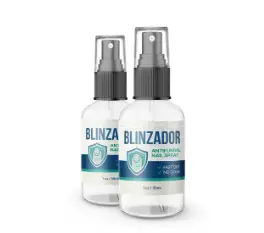Blinzador is sold as a fast‑drying, odor‑free foot and nail fungus spray, packed with plant‑based actives like undecylenic acid, lavender oil, jojoba oil, menthol, and vitamin E. Its sales pitch is sleek and compelling, boasting viral-worthy before-and-after photos and bold guarantees. But does it really work or is it just another funnel-driven product?
In this review, we break down what Blinzador claims, what the formula contains, key warning signs, and whether it can actually help with fungus.
Key Takeaways
- Main active ingredient, undecylenic acid, is clinically supported for antifungal use, but typical effective doses are around 10%.
- Formula includes lavender and jojoba oils, menthol, vitamin E, which are soothing and antimicrobial, but none are proven antifungals at spray concentrations .
- No clinical trials or third‑party testing for Blinzador itself, just general claims and testimonials.
- Marketing uses aggressive funnel tactics, scarcity offers, and bonuses, which are classic signs of high-pressure supplement marketing.
- Real antifungal alternatives with miconazole or terbinafine exist, backed by medical evidence and available OTC.

What Is Blinzador Anti‑Fungal Spray?
Blinzador is a 30 ml spray priced around $79–$294 per bottle, depending on bundle size. It’s promoted as a quicker, cleaner alternative to traditional creams or powders, with a 180‑day money‑back guarantee and glossy before-and-after social proof.
How It Claims to Work
When sprayed onto affected nails or skin twice daily, Blinzador is supposed to:
- Deliver undecylenic acid to inhibit fungal growth.
- Sooth and moisturize with jojoba and lavender oil.
- Provide a refreshing sensation via menthol.
- Repair and protect with vitamin E.
Ingredient Analysis
- Undecylenic Acid: FDA-backed antifungal; typically at 10% for effective use.
- Lavender Oil & Menthol: Mild antimicrobial effects; soothing but not proven against fungal agents.
- Jojoba Oil & Vitamin E: Helpful for skin hydration and repair.
- Unknown Concentrations: Blinzador doesn’t list concentrations or provide any lab certificates.
Red Flags to Consider
No Product-Specific Trials or Lab Data
There’s no scientific proof that Blinzador’s blend or delivery method works as advertised—only broad claims and bonus guides.
Pricing Strategy Reflects Funnels
The “Buy 6, Save $780” deal triggers urgency, but effectively costs $49 per bottle, meaning it’s likely funnel-based value-ballooning.
Testimonial Bias
Quotes and images are attractive, but no verifiable patient reviews or medical-controlled before-after aren’t sufficient evidence.
Better Proven OTC Alternatives Exist
Sprays like Lotrimin (miconazole) and Hongo Killer/Dr Blaine’s undecylenic acid are affordable, with known efficacy and regulatory backing.
Does It Actually Work?
Maybe, but likely nothing miraculous.
- Undecylenic acid has proven antifungal efficacy, but only at sufficient concentration (≈10%).
- Without ingredient percentages, its impact is guesswork.
- Testimonials may reflect normal recovery aided by basic hygiene and placebo, not so much from Blinzador’s formula itself.
Alternatives
Look to OTC options with validated antifungal ingredients:
- Lotrimin AF Spray (miconazole).
- Hongo Killer / Dr Blaine’s sprays.
- Touchless Care Spray.
- Terbinafine cream/spray.
Conclusion
Blinzador offers a sleek user experience and taps an effective antifungal agent, but it lacks transparency, proven dosage information, or clinical evidence. It may provide modest relief, but it doesn’t outpace affordable, well-researched OTC sprays with known efficacy.
If your issue is fungal, go with recognized ingredients like miconazole or prescription options. Only consider Blinzador if you’re drawn to the spray format and even then, move ahead cautiously and keep expectations modest
Also Read – Tryshereview.com Exposed: The Truth Behind the “Paid Product Reviewer” Claims
